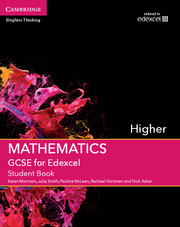Endorsed for the Edexcel GCSE Mathematics Higher tier specification for first teaching from 2015, this Student Book provides full coverage of the new GCSE Mathematics qualification. With a strong focus on developing problem-solving skills, reasoning and fluency, it helps students understand concepts, apply techniques, solve problems, reason, interpret and communicate mathematically. Written by experienced teachers, it also includes a solid breadth and depth of quality questions set in a variety of contexts. GCSE Mathematics Online - an enhanced digital resource incorporating progression tracking - is also available, as well as a free Teacher's Resource, Problem-solving Books and Homework Books.
Features
- Includes exercises with a variety of questions, including practice, investigatory, reasoning and problem-solving questions which gradually increase in difficulty, and link together sections and topics to develop fluency of mathematics, problem solving and reasoning skills.
- Exam-style questions to prepare students for assessment at the end of the two year linear course.
- Real life relevancy - chapters will begin with how the content of the chapter relates to work, linking to an example image and quote.
- ‘Before you start’ questions at the beginning of every chapter on each concept assess whether students can recall the necessary knowledge and skills required.
- Calculator tips included.
- A ‘Work it out’ feature will help draw out misconceptions. Featuring a set question or a problem with three possible solutions and one correct answer, containing common errors to act as teaching points.
- Every chapter includes a summary of the subject content covered in the chapter and a checklist against which students can check their knowledge and understanding in order to identify any gaps.
- End of chapter review questions act as summative assessment and revision.
- Split across 2 tiers – Foundation and Higher.
Table of Contents
- Introduction
- 1. Calculations
- 2. Shapes and solids
- 3. 2D representations of 3D shapes
- 4. Properties of whole numbers
- 5. Introduction to algebra
- 6. Fractions
- 7. Decimals
- 8. Powers and roots
- 9. Rounding, estimation and accuracy
- 10. Mensuration
- 11. Perimeter
- 12. Area
- 13. Further algebra
- 14. Surds
- 15. Equations
- 16. Functions and sequences
- 17. Formulae
- 18. Volume and surface area
- 19. Percentages
- 20. Ratio
- 21. Probability basics
- 22. Construction and loci
- 23. Vectors
- 24. Straight-line graphs
- 25. Graphs of functions and equations
- 26. Angles
- 27. Circles
- 28. Probability – combined events
- 29. Standard form
- 30. Similarity
- 31. Congruence
- 32. Pythagoras' theorem
- 33. Trigonometry
- 34. Growth and decay
- 35. Proportion
- 36. Algebraic inequalities
- 37. Sampling and representing data
- 38. Data analysis
- 39. Interpretation of graphs
- 40. Transformations
- 41. Transforming curves
- Glossary
- Index
- Acknowledgements.
Advice on useful tools
Advice on useful tools, activities and timetabling from teachers experiencing school closures.
Cambridge GO
All our supporting resources have now moved to Cambridge GO – the new home for your Cambridge digital content.
Listen to our podcast
Listen to our podcast to discover teaching inspiration & advice from leading educational thinkers.




